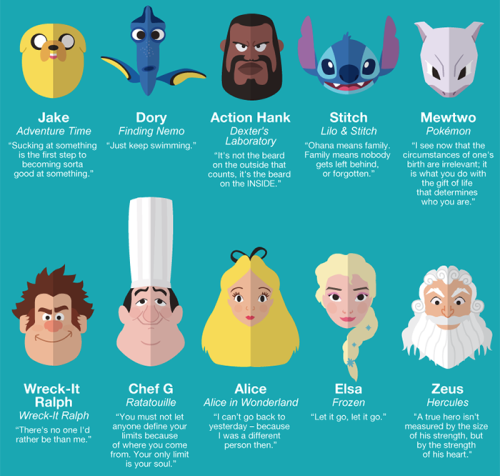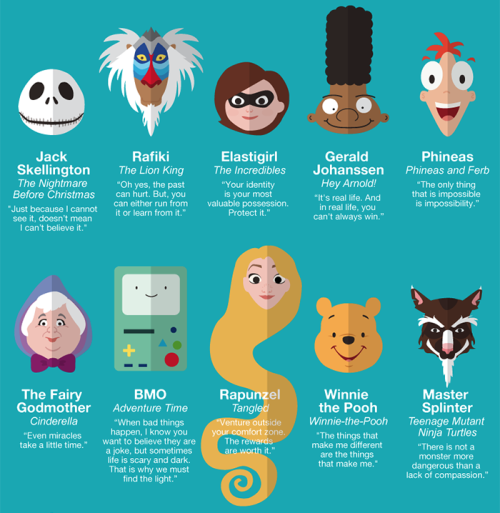W. M. Keck Observatory Telescopes Logo. December 2, 2014
W. M. Keck Observatory telescopes logo. December 2, 2014
Image above: A dusty planetary system (left) is compared to another system with little dust in this artist’s conception. Image Credit: NASA/JPL-Caltech. Planet hunters received some good news recently. A...
More Posts from Evisno and Others






Life Advice from 50 Beloved Characters in Kid’s Entertainment by AAA State of Play -source-
![WATCH: Crystal Birth, A Beautiful Timelapse Of Metallic Crystals Forming In Chemical Solutions [video]](https://64.media.tumblr.com/a6b789bd547bb0fc1e3119df87332f1a/tumblr_oghrhqfMiX1rte5gyo2_500.gif)
![WATCH: Crystal Birth, A Beautiful Timelapse Of Metallic Crystals Forming In Chemical Solutions [video]](https://64.media.tumblr.com/0c08f977f51ba218837b72a94f7bbd69/tumblr_oghrhqfMiX1rte5gyo4_500.gif)
![WATCH: Crystal Birth, A Beautiful Timelapse Of Metallic Crystals Forming In Chemical Solutions [video]](https://64.media.tumblr.com/94f32be0db445db0cdfe2546b015295b/tumblr_oghrhqfMiX1rte5gyo1_500.gif)
![WATCH: Crystal Birth, A Beautiful Timelapse Of Metallic Crystals Forming In Chemical Solutions [video]](https://64.media.tumblr.com/333f1f1da60d5ff8500aa7a751dba6c4/tumblr_oghrhqfMiX1rte5gyo3_500.gif)
WATCH: Crystal Birth, a Beautiful Timelapse of Metallic Crystals Forming in Chemical Solutions [video]



Comet ISON appears to have broken up and mostly evaporated as it travelled around the Sun, but something has made it around. It will be seen how much and in what condition. (Source of images) UPDATE: It is now confirmed that the comet is gone. Rest in pieces, ISON!

Cosmic horseshoe is not the lucky beacon
A UC Riverside-led team of astronomers use observations of a gravitationally lensed galaxy to measure the properties of the early universe
Although the universe started out with a bang it quickly evolved to a relatively cool, dark place. After a few hundred thousand years the lights came back on and scientists are still trying to figure out why.
Astronomers know that reionization made the universe transparent by allowing light from distant galaxies to travel almost freely through the cosmos to reach us.
However, astronomers don’t fully understand the escape rate of ionizing photons from early galaxies. That escape rate is a crucial, but still a poorly constrained value, meaning there are a wide range of upper and lower limits in the models developed by astronomers.
That limitation is in part due to the fact that astronomers have been limited to indirect methods of observation of ionizing photons, meaning they may only see a few pixels of the object and then make assumptions about unseen aspects. Direct detection, or directly observing an object such as a galaxy with a telescope, would provide a much better estimate of their escape rate.
In a just-published paper, a team of researchers, led by a University of California, Riverside graduate student, used a direct detection method and found the previously used constraints have been overestimated by five times.
“This finding opens questions on whether galaxies alone are responsible for the reionization of the universe or if faint dwarf galaxies beyond our current detection limits have higher escape fractions to explain radiation budget necessary for the reionization of the universe,” said Kaveh Vasei, the graduate student who is the lead author of the study.
It is difficult to understand the properties of the early universe in large part because this was more than 12 billion year ago. It is known that around 380,000 years after the Big Bang, electrons and protons bound together to form hydrogen atoms for the first time. They make up more than 90 percent of the atoms in the universe, and can very efficiently absorb high energy photons and become ionized.
However, there were very few sources to ionize these atoms in the early universe. One billion years after the Big Bang, the material between the galaxies was reionized and became more transparent. The main energy source of the reionization is widely believed to be massive stars formed within early galaxies. These stars had a short lifespan and were usually born in the midst of dense gas clouds, which made it very hard for ionizing photons to escape their host galaxies.
Previous studies suggested that about 20 percent of these ionizing photons need to escape the dense gas environment of their host galaxies to significantly contribute to the reionization of the material between galaxies.
Unfortunately, a direct detection of these ionizing photons is very challenging and previous efforts have not been very successful. Therefore, the mechanisms leading to their escape are poorly understood.
This has led many astrophysicists to use indirect methods to estimate the fraction of ionizing photons that escape the galaxies. In one popular method, the gas is assumed to have a “picket fence” distribution, where the space within galaxies is assumed to be composed of either regions of very little gas, which are transparent to ionizing light, or regions of dense gas, which are opaque. Researchers can determine the fraction of each of these regions by studying the light (spectra) emerging from the galaxies.
In this new UC Riverside-led study, astronomers directly measured the fraction of ionizing photons escaping from the Cosmic Horseshoe, a distant galaxy that is gravitationally lensed. Gravitational lensing is the deformation and amplification of a background object by the curving of space and time due to the mass of a foreground galaxy. The details of the galaxy in the background are therefore magnified, allowing researchers to study its light and physical properties more clearly.
Based on the picket fence model, an escape fraction of 40 percent for ionizing photons from the Horseshoe was expected. Therefore, the Horseshoe represented an ideal opportunity to get for the first time a clear, resolved image of leaking ionizing photons to help understand the mechanisms by which they escape their host galaxies.
The research team obtained a deep image of the Horseshoe with the Hubble Space Telescope in an ultraviolet filter, enabling them to directly detect escaping ionizing photons. Surprisingly, the image did not detect ionizing photons coming from the Horseshoe. This team constrained the fraction of escaping photons to be less than 8 percent, five times smaller than what had been inferred by indirect methods widely used by astronomers.
“The study concludes that the previously determined fraction of escaping ionizing radiation of galaxies, as estimated by the most popular indirect method, is likely overestimated in many galaxies,” said Brian Siana, co-author of the research paper and an assistant professor at UC Riverside.
“The team is now focusing on direct determination the fraction of escaping ionizing photons that do not rely on indirect estimates.”

1976 … space station colonies
by x-ray delta one



HIV virus particle, budding influenza virus and HIV in blood serum as illustrated by David S. Goodsell.
Goodsell is a professor at the Scripps Research Institute and is widely known for his scientific illustrations of life at a molecular scale. The illustrations are usually based on electron microscopy images and available protein structure data, which makes them more or less accurate. Each month a new illustrated protein structure can be found in Protein Data Bank molecule of the month section and you can read more on how his art is made here.





Nearly every day Cassini sends back something amazing to sit and wonder at.
1) Saturn’s rings, 15 July 2014
2) Tethys / Saturn’s rings 14 July 2014
3) Disk of Saturn 14 July 2014
4) Prometheus / F Ring 13 July 2014
5) Pan in the Encke Gap 13 July 2014
All raw and unprocessed images from saturn.jpl.nasa.gov

Radar Observations of Asteroid 2014 HQ124
Radar data of asteroid 2014 HQ124 taken over for hours on June 8, 2014, when the asteroid was between 864.000 miles (1.39 million kilometers) and 902.00 miles (1,45 million kilometers) from Earth. The data reveals asteroid 2014 HQ124 to be an elongated, irregular object that is at least 1200 feet (370 meters) wide on it long axis. The radar was obtained using NASA’s 70 meters Goldstone antenna, the same antenna used for communicating with spacecraft in deep space. The Goldstone radar team paired with the Arecibo Observatory (Goldstone sending radar, Arecibo receiving) for the first five frames of this movie in order to collect higher quality data resulting in shaper images. The other frames were made by both sending and receiving with antennas at the Goldstone complex.
Credit: NASA/JPL
-
 the-geeky-farmer reblogged this · 10 years ago
the-geeky-farmer reblogged this · 10 years ago -
 duvies liked this · 10 years ago
duvies liked this · 10 years ago -
 starhasarrived reblogged this · 10 years ago
starhasarrived reblogged this · 10 years ago -
 starhasarrived liked this · 10 years ago
starhasarrived liked this · 10 years ago -
 dragawayofdawn liked this · 10 years ago
dragawayofdawn liked this · 10 years ago -
 evisno reblogged this · 10 years ago
evisno reblogged this · 10 years ago -
 quasigeostrophy liked this · 10 years ago
quasigeostrophy liked this · 10 years ago -
 seiscience reblogged this · 10 years ago
seiscience reblogged this · 10 years ago -
 gryphonsmadre liked this · 10 years ago
gryphonsmadre liked this · 10 years ago -
 sidekickkep liked this · 10 years ago
sidekickkep liked this · 10 years ago -
 invisible-alien-asshole reblogged this · 10 years ago
invisible-alien-asshole reblogged this · 10 years ago -
 thenotso90skid-blog liked this · 10 years ago
thenotso90skid-blog liked this · 10 years ago -
 vobi-blog liked this · 10 years ago
vobi-blog liked this · 10 years ago -
 driflooons-blog liked this · 10 years ago
driflooons-blog liked this · 10 years ago -
 wanderingwondererofthings liked this · 10 years ago
wanderingwondererofthings liked this · 10 years ago -
 vajohna liked this · 10 years ago
vajohna liked this · 10 years ago -
 siresword liked this · 10 years ago
siresword liked this · 10 years ago -
 haileylion liked this · 10 years ago
haileylion liked this · 10 years ago -
 twomoon reblogged this · 10 years ago
twomoon reblogged this · 10 years ago -
 foxrojo liked this · 10 years ago
foxrojo liked this · 10 years ago -
 atrumdeus reblogged this · 10 years ago
atrumdeus reblogged this · 10 years ago -
 socialhazardmediallc liked this · 10 years ago
socialhazardmediallc liked this · 10 years ago -
 kaitlinthestudent reblogged this · 10 years ago
kaitlinthestudent reblogged this · 10 years ago -
 theterribleseamonster-blog reblogged this · 10 years ago
theterribleseamonster-blog reblogged this · 10 years ago -
 thehorribleseamonster-blog liked this · 10 years ago
thehorribleseamonster-blog liked this · 10 years ago -
 40milesfromthesun liked this · 10 years ago
40milesfromthesun liked this · 10 years ago -
 heliosphoenix reblogged this · 10 years ago
heliosphoenix reblogged this · 10 years ago -
 occey liked this · 10 years ago
occey liked this · 10 years ago -
 dreadgeek liked this · 10 years ago
dreadgeek liked this · 10 years ago -
 rowingiscool liked this · 10 years ago
rowingiscool liked this · 10 years ago -
 feverchills-blog liked this · 10 years ago
feverchills-blog liked this · 10 years ago -
 illfrickyourfrack liked this · 10 years ago
illfrickyourfrack liked this · 10 years ago -
 spaceexp reblogged this · 10 years ago
spaceexp reblogged this · 10 years ago




